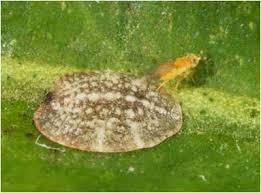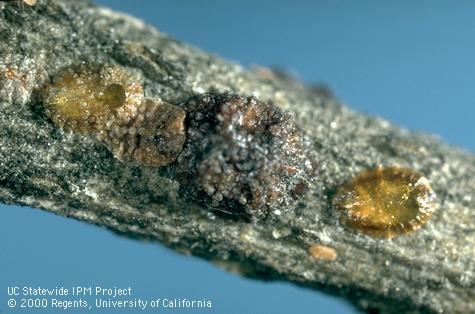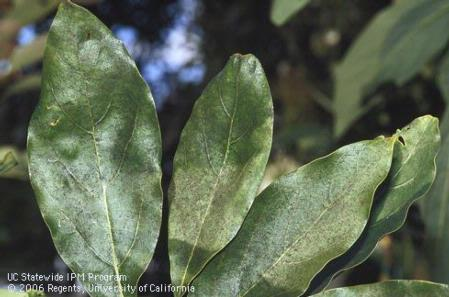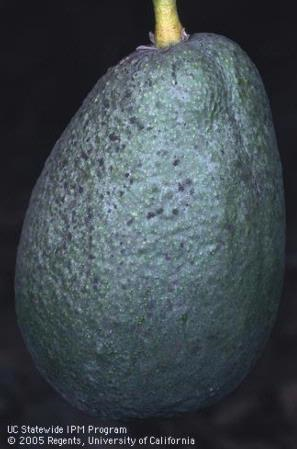Biological control is the management of pests and their damage by the beneficial action of parasites (parasitoids), pathogens, and predators. These beneficial organisms, collectively, are named natural enemies.
Conserving (or protecting) and releasing natural enemies are important components of integrated pest management (IPM). In most situations, employing practices that conserve natural enemies is more effective, and less expensive and time consuming, than purchasing and releasing them.
Learn about the specific situations where purchasing and releasing parasites and predators can increase the effectiveness of biological control. Before purchasing natural enemies, consult the University of California (UC) IPM Pest Management Guidelines for that crop to learn whether UC research has shown that releasing them is effective. Some natural enemies on the market have never been demonstrated to effectively control any agricultural pest in California.
Obtaining Natural Enemies
Natural enemies can be purchased directly from various producers (companies that rear them) and suppliers (companies that purchase from producers and repackage and resell them). Some sources of parasites and predators are members of the Association of Natural Biocontrol Producers (ANBP). All ANBP members formally agree to a code of ethics and standardized methods.
Natural enemies purchased by users are commonly delivered via shipping services. Purchase parasites and predators only from in-state providers. It is illegal to obtain insects and other arthropods outside of California and carry or have them shipped across state lines without a permit from agricultural officials. Some pest control advisers and pest scouts will procure and release natural enemies as a service for growers.
Methods for Releasing Natural Enemies
Two methods for releasing natural enemies are inoculation and inundation:
- Inoculation—relatively few natural enemies are released. The offspring of these natural enemies provide biological control, not the individuals released.
- Inundation—large numbers of natural enemies are released, often several times over a growing season. The natural enemies released, and possibly their offspring, provide biological control.
The mealybug destroyer is an example of a natural enemy that is only released through inoculation—at relatively low numbers once per year early in the growing season. Aphytis melinus and Trichogramma parasites are released by inundation—at regular intervals over the growing season—to control California red scale and eggs of pest moths, respectively. Both inoculation and inundation can be used with predatory mites, depending on the situation.
Releasing Natural Enemies Effectively
Releasing natural enemies is most likely to be effective in situations where: 1) University of California researchers or other pest management experts have previously demonstrated success and 2) some level of pests and their damage can be tolerated in that crop. Desperate situations are not good opportunities for releasing natural enemies. Pests or their damage may already be too widespread for any release of parasites or predators to prevent economic loss of crop quality or quantity.
Increase the likelihood that natural enemy releases will be effective by
- Accurately identifying the pest and its natural enemies.
- Learning about the biology of the pest and its natural enemies.
- Releasing the appropriate natural enemy life stage and species.
- Releasing when the pests' vulnerable life stage(s) are present and at numbers that can be controlled by natural enemy releases.
Natural enemies are unlikely to be effective when released as if you were applying a pesticide. Instead, anticipate pest problems and begin making releases before pests are too abundant or economic damage is imminent.
- Remember that natural enemies are living organisms that require food, shelter, and water. Protect them from extreme conditions. For example, release them at night or early in the day during hot weather.
- Avoid applying broad-spectrum, residual (persistent) insecticides and miticides, and in some situations certain systemic or other pesticides, before or after releasing natural enemies. When needed, use pesticides selectively. For example, spot spray only where pests are abundant but localized.
Common reasons for the lack of satisfactory biological control after releases include the
- Application of broad-spectrum, residual insecticides, or in some situations systemic or other pesticides, prior to or after a release.
- Incorrect timing of release.
- Release of the wrong natural enemy for the pest situation.
- Release of a natural enemy species that is known to be ineffective.
For information on the use of biological control, see the UC IPM Pest Management Guidelines for your crop and specific pests. Most crops have a table called “Relative Toxicities of Insecticides and Miticides to Natural Enemies and Honey Bees” in the “General Information” section. Use these resources to guide pesticide selection to conserve natural enemies and improve biological pest control.
More Information
this is a repost from:
https://www2.ipm.ucanr.edu/agriculture/natural-enemy-releases-for-biological-control-of-crop-pests/?src=redirect2refresh
Photo: Adult Aphytis melinus parasite laying her egg in California red scale, Aonidiella aurantii. Releases are most effective when ants are controlled, dust is minimized, and broad spectrum pesticide applications are avoided. Credit: Jack Kelly Clark, UC IPM Program
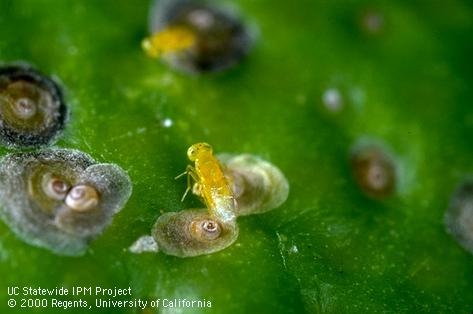
Aphytis
Posted on
Monday, July 1, 2019 at
10:36 AM
Home is where the habitat is: This Earth Day, consider installing insectary plants
—Stephanie Parreira, UC Statewide IPM Program
Help the environment this Earth Day, which falls on Sunday April 22 this year, by installing insectary plants! These plants attract natural enemies such as lady beetles, lacewings, and parasitic wasps. Natural enemies provide biological pest control and can reduce the need for insecticides. Visit the new UC IPM Insectary Plants webpage to learn how to use these plants to your advantage.
The buzz about insectary plants
Biological control, or the use of natural enemies to reduce pests, is an important component of integrated pest management. Fields and orchards may miss out on this control if they do not offer sufficient habitat for natural enemies to thrive. Insectary plants (or insectaries) can change that—they feed and shelter these important insects and make the environment more favorable to them. For instance, sweet alyssum planted near lettuce fields encourages syrphid flies to lay their eggs on crops. More syrphid eggs means more syrphid larvae eating aphids, and perhaps a reduced need for insecticides. Similarly, planting cover crops like buckwheat within vineyards can attract predatory insects, spiders, and parasitic wasps, ultimately keeping leafhoppers and thrips under control.
Flowering insectaries also provide food for bees and other pollinators. There are both greater numbers and more kinds of native bees in fields with an insectary consisting of a row of native shrubs planted along the field edge (called a hedgerow). Native bees also stay in fields with these shrubs longer than they do in fields without them. Therefore, not only do insectaries attract natural enemies, but they can also boost crop pollination and help keep bees healthy.
Insectary plants may attract more pests to your crops, but the benefit is greater than the risk
The possibility of creating more pest problems has been a concern when it comes to installing insectaries. Current research shows that mature hedgerows, in particular, bring more benefits than risks. Hedgerows attract far more natural enemies than insect pests. And despite the fact that birds, rabbits, and mice find refuge in hedgerows, the presence of hedgerows neither increases animal pest problems in the field, nor crop contamination by animal-vectored pathogens. Hedgerow insectaries both benefit wildlife and help to control pests.
How can I install insectary plants?
Visit the Insectary Plants webpage to learn how to establish and manage insectary plants, and determine which types of insectaries may suit your needs and situation. If you need financial assistance to establish insectaries on your farm, consider applying for Conservation Action Plan funds from the Environmental Quality Incentives Program (EQIP) offered by the Natural Resources Conservation Service.
Sources:
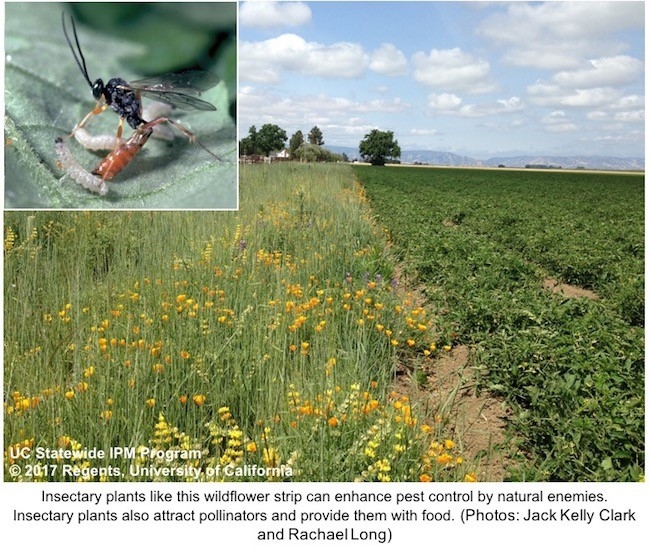
insectary plants
Posted on
Thursday, April 19, 2018 at
10:26 AM
Control of Argentine ant in many situations, means controlling many other pests in citrus and other crops. Here is one of their techniques for their success at being so disruptive
Compounds produced by Argentine ants are used to recruit nest mates and incapacitate opponents
University of California - Riverside
RIVERSIDE, Calif. -- From their native home on the banks of South America's Paraná River, Argentine ants have conquered six continents and many oceanic islands. Their success is explained by several factors: they have more than one queen per colony, making them difficult to eradicate, and they adapt to changes in their environments by living transiently rather than building permanent nests.
Argentine ants are also highly aggressive, out-competing existing ant species for food and other resources. In a paper published today in Scientific Reports, researchers at the University of California, Riverside show how Argentine ants use chemical secretions as weapons in their interactions with harvester ants, which are native to California. The findings could help in the development of new pest control strategies.
Although they originated in a tropical ecosystem, Argentine ants are a major nuisance in California and the southern U.S., where they thrive in urban areas with artificial irrigation. They also pose natural and economic threats, competing with native ants and pollinators, and protecting plant pests such as aphids and scales in return for the sweet honeydew secretions that these insects produce.
Like many social insects, Argentine ants communicate via an assortment of chemicals that they excrete from their gaster (abdomen). During aggressive interactions, Argentine ants exhibit a behavior called gaster bending, where they place the tip of their gaster onto their opponent's body. Based on behavioral observations, researchers have long inferred that, during this interaction, Argentine ants may spray or dab irritant chemicals onto their opponent's body.
The UCR researchers confirmed this experimentally, showing that Argentine ants produce secretions containing two compounds (dolichodial and iridomyrmecin), which they apply to the surface of harvester ants during aggressive interactions. The research was led by Dong-Hwan Choe, an assistant cooperative extension specialist and assistant professor of entomology in UCR's College of Natural and Agricultural Sciences.
Choe's team investigated the effect of these compounds on harvester ants, showing they caused both irritation and disorientation. The compounds also attracted other Argentine ants to the area, allowing them to mount a larger, coordinated response to the native ant species.
"This research finding experimentally verified the long-held assumption that Argentine ants use gaster-produced compounds during aggressive interactions with other ant species. They use these compounds not only for incapacitating the opponent, but also for calling more nestmates from nearby locations for their help in combat," Choe said.
Choe said synthetic versions of these chemicals could be used to develop new pest management strategies with a greater selectivity.
"Potentially, these compounds could be used in a bait to attract Argentine ants toward a poison while at the same time acting as a deterrent to harmless native ants," he said.
###
The title of the paper is "Verification of Argentine Ant Defensive Compounds and Their Behavioral Effects on Heterospecific Competitors and Conspecific Nestmates." In addition to Choe, contributors include first author Kevin Welzel, who completed his Ph.D. in Choe's lab at UCR; Shao Hung Lee, an entomology undergraduate at UCR; Aaron Dossey at All Things Bugs, LLC; and Kamlesh Chauhan, at the USDA-Agricultural Research Service.
Cation:
Using an action called gaster bending, Argentine Ants dab irritant chemicals onto their opponent's body
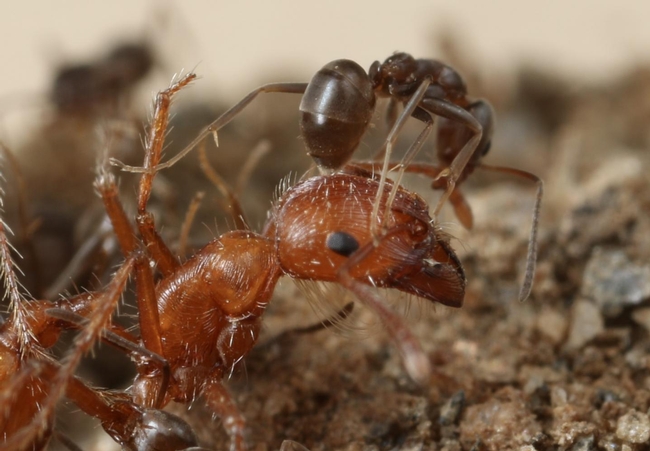
argnetine ant attacking opponent ant
Posted on
Monday, February 5, 2018 at
6:13 AM
We live in unusual times and every year is different, so we are bound to see things that are different, or see things differently. Recently a pest control advisor brought in a sample of what looked like black scale (Saissetia oleae) on the stems of avocado fruit. Along with the scale came a mess of Argentine ant and sooty mold. The PCA had not seen this scale on avocado before. It is common on citrus and, from the name, it is also found on olives and over 100 other host-plants. I hadn't seen it on avocado before, and became somewhat alarmed and sent samples off to UC Riverside for identification. I thought maybe there might have been an introduction of a new scale, riding on imported fruit. Joe Morse and crew from UCR had done a study monitoring fruit coming across the border and found several scales on fruit that were not currently in California:
http://entnemdept.ufl.edu/Hodges/als4161/Secure/PDF%20Files/Articles/AvocadoPhytosanitaryRisks.pdf
Back with the first infestations of Avocado thrips in 1996, PCA Charlie Gribble kept saying that he was finding citrus thrips in avocado. The avocado orchards where he found the thrips were next to a lemon orchard and we kept saying that the insect was probably just getting lost between the two orchards. Well it turned out, it wasn't citrus thrips, but an all new thrips previously undescribed that has gone on to cause a lot of disruption to the California avocado industry. And from here, avocado thrips has gone on to Israel and Spain to cause similar problems. It was better to find out sooner than later it this scale was something new.
I also put the word out to local PCAs and growers asking if they had seen “black scale” this year. The responses were interesting. One grower said that he had seen it occasionally on avocado trees for the last 30 years. They were on older trees and wood. They would be in small numbers in orchards some years and not others. Two PCAs said that they saw it occasionally on young trees, but they were usually parasitized, with wasp exit holes. One PCA said that the scale was only there when there were lots of ants present to fend off parasitic wasps.
Photos: parasitic wasp laying eggs and exit hole of young wasp from adult scale
And bingo, that was the case in this organic orchard with smaller trees. The Argentine ants were protecting the scale and the scale was thriving as evidenced by the sooty mold.
The black scale samples sent into Paul Rugman-Jones at UCR Entomology were identified as the scale Saissetia olea and that virtually all of them were parasitized by the Coccophagus rusti wasp. So it's not a new scale and it's under biological control.
Photos: Sooty mold on avocado leaves and fruit
Nice coverage of scales:
https://www.dialenvironmental.com/images/scales.pdf
http://ipm.ucanr.edu/PMG/r107301411.html
For a guide to the scales of California, big files and illustrations:
https://www.cdfa.ca.gov/plant/PPD/publications/tech_series.html
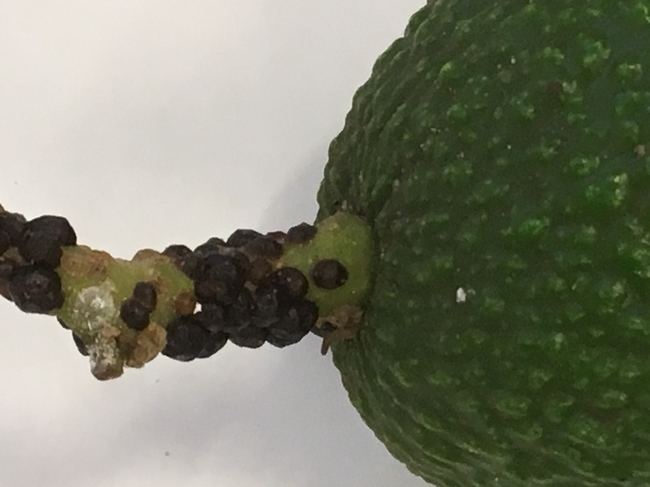
black scale avocado
Posted on
Monday, October 30, 2017 at
7:31 AM
TYPES OF NATURAL ENEMIES
Parasites, pathogens, and predators are the primary groups used in biological control of insects and mites (Table 1). Most parasites and pathogens, and many predators, are highly specialized and attack a limited number of closely related pest species. Learn how to recognize natural enemies by consulting resources such as the Natural Enemies Handbook and the Natural Enemies Gallery.
Parasites
A parasite is an organism that lives and feeds in or on a host. Insect parasites can develop on the inside or outside of the host's body. Often only the immature stage of the parasite feeds on the host. However, adult females of certain parasites (such as many wasps that attack scales and whiteflies) feed on and kill their hosts, providing an easily overlooked but important source of biological control in addition to the host mortality caused by parasitism.
Although the term “parasite” is used here, true parasites (e.g., fleas and ticks) do not typically kill their hosts. Species useful in biological control, and discussed here, kill their hosts; they are more precisely called “parasitoids.”
Most parasitic insects are either flies (Order Diptera) or wasps (Order Hymenoptera). Parasitic wasps occur in over three dozen Hymenoptera families. For example, Aphidiinae (a subfamily of Braconidae) attack aphids. Trichogrammatidae parasitize insect eggs. Aphelinidae, Encyrtidae, Eulophidae, and Ichneumonidae are other groups that parasitize insect pests. It's important to note that these tiny to medium-sized wasps are incapable of stinging people. The most common parasitic flies are the typically hairy Tachinidae. Adult tachinids often resemble house flies. Their larvae are maggots that feed inside the host.
Pathogens
Natural enemy pathogens are microorganisms including certain bacteria, fungi, nematodes, protozoa, and viruses that can infect and kill the host. Populations of some aphids, caterpillars, mites, and other invertebrates are sometimes drastically reduced by naturally occurring pathogens, usually under conditions such as prolonged high humidity or dense pest populations. In addition to a naturally occurring disease outbreak (epizootic), some beneficial pathogens are commercially available as biological or microbial pesticides. These include Bacillus thuringiensis or Bt, entomopathogenic nematodes, and granulosis viruses. Additionally, some microorganism by-products, such as avermectins and spinosyns are used in certain insecticides; but applying these products is not considered to be biological control.
Predators
Predators kill and feed on several to many individual prey during their lifetimes. Many species of amphibians, birds, mammals, and reptiles prey extensively on insects. Predatory beetles, flies, lacewings, true bugs (Order Hemiptera), and wasps feed on various pest insects or mites. Most spiders feed entirely on insects. Predatory mites that feed primarily on pest spider mites include Amblyseius spp., Neoseiulus spp., and the western predatory mite, Galendromus occidentalis.
AUGMENTATION
When resident natural enemies are insufficient, their populations can sometimes be increased (augmented) through the purchase and release of commercially available beneficial species. However, there has been relatively little research on releasing natural enemies in gardens and landscapes. Releases are unlikely to provide satisfactory pest control in most situations. Some marketed natural enemies are not effective. Many natural enemies are generalist predators and are cannibalistic and feed indiscriminately on pest and beneficial species, thereby reducing their effectiveness.
Only a few natural enemies can be effectively augmented in gardens and landscapes. For example, entomopathogenic nematodes can be applied to control certain tree-boring and lawn-feeding insects. Convergent lady beetles (Hippodamia convergens) purchased in bulk through mail order, stored in a refrigerator, and released in very large numbers at intervals can temporarily control aphids; however, lady beetles purchased through retail outlets are unlikely to be sufficient in numbers and quality to provide control.
Successful augmentation generally requires advanced planning, biological expertise, careful monitoring, optimal release timing, patience, and situations where certain levels of pests and damage can be tolerated. Situations where pests or damage are already abundant are not good opportunities for augmentation.
A classic example of poor timing for augmentative release of predatory mites for control of broad mite in coastal lemon or persea mite in avocado is right now. Pest populations for the most part have soared and releasing predatory mites is little help. Predatory mites need to be releases into a small growing population, so in both of these cases it would have been better to start small, frequent releases early and throughout the spring to knock their populations back.
Adult predatory mite, Euseius tularensis, and citrus red mite.

predatory mite
Posted on
Monday, August 10, 2015 at
8:15 AM
Tags:
avocado (389),
biocontrol (21),
broad mite (3),
citrus (468),
mealy bug (2),
parasatoids (3),
parasites (6),
persea mite (2),
pests (141),
predators (4),
predatory mites (2)





